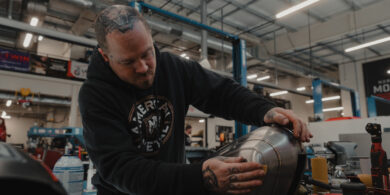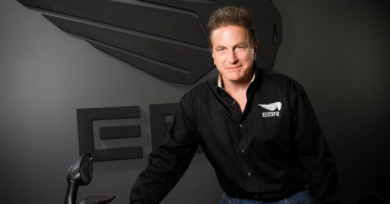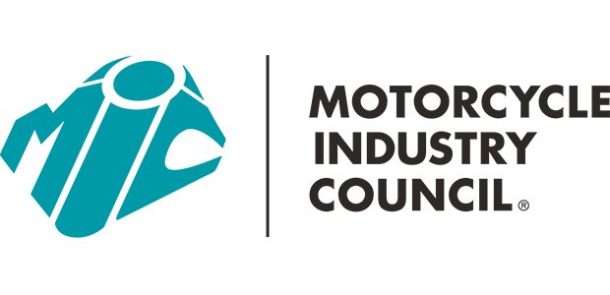An adapting engine operation – April 3, 2006
GUNSKIRCHEN, Austria — The yellow and red cords hang down from each assembly line at the Rotax engine factory like children’s abandoned jump ropes.
Pull the red one, the one for emergencies, and the line stops immediately.
Pull the yellow one and strains from the popular Beatles’ song “Help” drift across the factory floor: “Help, I need somebody; Help, not just anybody; Help, you know I need someone, help.”
At the same time, numbers for the worker’s station and line pop up on a gigantic scoreboard above the production floor. A supervisor is at the trouble spot within moments, the problem is handled, and production continues.
The music is a bit of light-hearted humor, perhaps, at an unexpected moment in this home of serious high-performance engines for airplanes, racing karts and powersports equipment. But it exemplifies an attitude across this facility, one of teamwork and pride and a push for excellence.
There are five production lines here now, down from 14 lines that ran before a major reorganization and improvement program was launched several years ago. The impetus for change came when Rotax’s parent company, Bombardier Recreational Products (BRP), was sold in 2003 to a group of investors led by Bain Capital, the private equity firm based in Boston.
“Our fear was that Bain would emphasize the short term, but that hasn’t been the case,” says Yves Leduc, vice president and general manager of Rotax. “We’ve become a stronger company (since the sale) because Bain has forced us to set higher standards. We’ve become better because they’ve set extremely tight operating targets, but we’re free to define strategies.” Rotax is a wholly owned subsidiary of BRP and is a stand-alone operation, even though it functions as an operating division of BRP.
Rotax produces all of the engines for BRP’s powersports products: ATVs, snowmobiles and PWC. It also produces aircraft engines and racing karts, as well as motorcycle engines for Aprilia and BMW. Rotax will produce about 225,000 engines this year, about half the number produced by Piaggio Group, for example, and a far cry from the numbers put up by Japanese motorcycle manufacturers.
So what makes Rotax different from other engine makers around the world, from North America to Asia? Perhaps it’s the emphasis on excellence and product performance, or teamwork and employee loyalty, or corporate flexibility — the willingness to change what it’s doing. Or, it could be all of these things.
Consider that average employee longevity is 12 years.
Or consider Rotax’s failed scooter business. In 2001, it was producing close to 80,000 small displacement scooter engines. Today, it’s out of the business. The reason is simple, says Rotax management: Scooter engines became a commodity produced by the Chinese and Rotax isn’t in the commodity business, it’s in the performance business. Building scooter engines wasn’t a game Rotax could win, so it got out of the business. But today the company is making more money than when it made scooter motors because the engines it sells today are bigger and more profitable.
Rotax management read the situation and quickly moved in another direction rather than hanging on to a losing position. In commodities, Rotax doesn’t have much of a future, says Leduc.
“Our strategy,” he says, “is to focus on engines that make a difference and to focus on our ability to build at the lowest cost in the most efficient way.”
Adds one manager when asked if Rotax would enter the American V-twin market: “Our engines produce performance,” he says soberly, “not just noise.”
Rotax isn’t a manufacturer in the true sense of the word because it doesn’t build all of its parts. But it does design the parts, outsource some of them and then finish those pieces before assembling the motor. Rotax has substantial partnerships for sourcing in India and other parts of Asia.
It also borrows heavily from the automotive industry. Gerd Ohrnberger is Rotax’s vice president and managing director of product development. He spent years at Porsche before joining Rotax, and he’s not ashamed to take ideas from automakers. Two lessons are important here:
First, he borrowed the ECU used by Mercedes and produced by a third party supplier as the “brain” for his engines. Why spend money and time developing a product that’s already been tested by one of the best auto companies in the world? Today, that piece is a key component in Rotax engines.
Second, he created a system for designing a family of engines, products that use the same parts. This is one of the keys to Rotax’s ability to quickly develop new products and produce them efficiently. The same relatively small group of engine components are used across a family of engines and applications.
So, points out Leduc, Rotax succeeds because it emphasizes two things:
This approach yields fast development and low manufacturing costs.
The single location here means development, procurement and manufacturing are tightly integrated. The single location advantage is leveraged to the maximum, say Rotax managers. The obvious question, then, is: Won’t this advantage be lost when Rotax opens its first remote plant, in Juarez, Mexico, where BRP is shifting its ATV production?
No, says Leduc, adding the new plant will offer Rotax several advantages. He’ll keep R&D here and will develop systems to maintain quality in Mexico. The move to a country with a low cost of production is expected to enable Rotax to develop opportunities in other markets while it becomes more competitive on the ATV side. “Mexico will be in many ways an extension of Austria,” says Leduc, “but it’s a challenge. We’ll have to develop a business model to handle it.”
More than powersports
Rotax holds one more card in its collection of competitive advantages. It builds aircraft engines. Not many, only a few thousand annually. But it’s not the number that’s important; it’s the technology and systems needed to get the job done.
The V-6 engines are built on a special line in an isolated room separated from the main manufacturing operations. It’s not about volume here, it’s about quality and getting the job done right.
Rotax is No. 1 with 80 percent market share in the 80-115 hp segment and management believes it can continue to grow in this area. “There’s no engine companies in (this segment of) the aircraft engine that has our strengths,” says Leduc. “Most companies have fewer than 100 employees.”
Basically, he says, small aircraft technology hasn’t changed in 50 years. So, Rotax is taking auto technology and adapting it to this segment of the aircraft. It’s a nice place to be for Rotax because the margins are very high and government mandated controls are so stiff. The quality controls developed here are easily adapted to the powersports side of the business, says Rotax management.
The Future
The people at Rotax believe in what BRP President Jose Boisoli says: BRP will be on the road one day soon. “Motorcycles are part of the DNA of Rotax,” says Leduc, pointing out that it builds engines for Aprilia and is building a two-cylinder power plant for BMW.
“There’s a very important advantage to having an engine business that does OEM (motorcycle) business — it allows BRP access to technologies that it wouldn’t have otherwise. We have a huge degree of expertise in motorcycling. Other than buying a motorcycle company,” says Leduc, “this provides extreme flexibility for BRP.”
Even in the most conservative case, Rotax’s OEM business is a distinctive business that can generate nice profits for BRP. “We’re an integral part of BRP,” says Leduc, “but Rotax is a distinct business of its own. It’s a growing business that makes money,” he says, but declines to provide specific numbers for the closely held company.
Based upon its recent performance, it won’t be surprising to see Rotax play an increasingly important role for BRP from its base in this small Austrian community. psb




